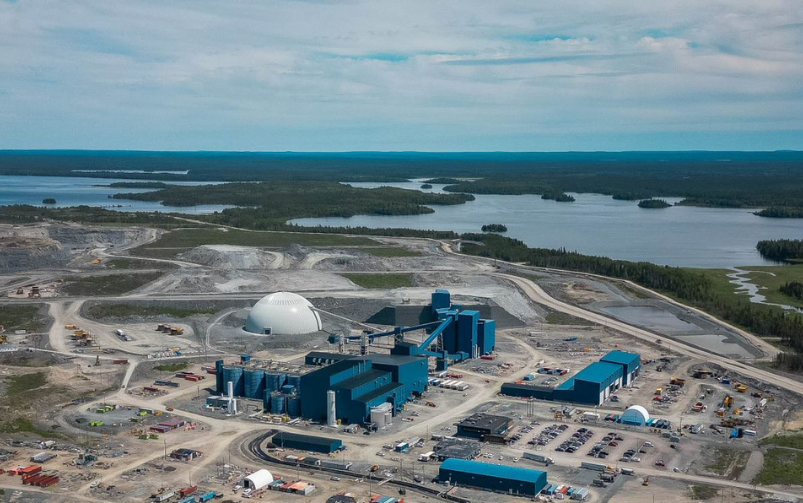Equinox Gold poured first gold at its Greenstone mine in northwestern Ontario this week. It will be one of Canada’s largest gold mines once it begins commercial production. Courtesy of Equinox Gold.
Welcome back to your weekly mining news recap, where we catch you up on some of the news you may have missed. This week’s headlines include an order to keep miners out of loader buckets, New Gold boosting its stake in the New Afton mine and five Canadian provinces coming out on top in a report ranking the investment attractiveness of mining jurisdictions.
Equinox Gold announced that it had poured first gold at its flagship Greenstone mine on Wednesday. The mine, which is located close to Geraldton, Ontario, yielded 1,800 ounces of gold from the inaugural pour and the company reported that all machinery is up and running. When operating at full capacity, the mine is expected to produce around 400,000 ounces of gold annually during its first five years, and then about 360,000 ounces of gold per year for the rest of its current 14-year mine life.
Vancouver-based Solaris Resources has dropped a financing deal with Chinese company Zijin Mining Group after the deal failed to gain regulatory approval from Ottawa, as reported by the Globe and Mail. Zijin Mining was set to pay $130 million in exchange for a 15 per cent equity stake in Solaris. The funds from the deal were intended to aid Solaris in progressing its Warintza copper project in Ecuador. If the deal went through, Zijin would have gained a seat on the Solaris board.
Anglo American has agreed to enter talks with BHP about a takeover after it rejected the rival miner’s third offer to acquire the company on Wednesday, which was valued at $67.3 billion, as reported by Bloomberg. Anglo has also offered an extended deadline of May 29 for BHP to come back with a binding bid. If BHP does not commit to an offer, it must walk away for a period of six months, under takeover rules in the U.K.
The Ontario Labour Relations Board has upheld a directive from the province’s Ministry of Labour in 2022 that forbids the use of underground loader buckets as lifts for workers. This decision followed an incident in 2022 where a Cementation Canada worker was injured at New Gold’s Rainy River mine, as reported by Northern Ontario Business. Cementation had appealed the stop-work order against using the buckets as lifts so that workers could access and load elevated blast holes, stating that it was possible to do so in a safe manner by using lanyards. In this recent development, the board affirmed that the stop-work order was necessary and the equipment is not intended to be used as a work platform.
Miners are boosting their stakes in operations this week. New Gold has raised $235.8 million in bought deal equity financing, which it will use to increase its ownership of the New Afton mine in B.C. to 80.1 per cent, as reported by Canadian Mining Journal. This involves buying back part of the Ontario Teachers’ Pension Plan board’s stake in the operation. Meanwhile, Iamgold raised $411 million to repurchase a further 9.7 per cent interest in the Côté gold mine in Ontario from Sumitomo Metal Mining, which would grant Iamgold 70 per cent ownership of the mine.
Hudbay Minerals raised more than US$402 million in an equity offering, some of which will be used in order to finance growth at its Copper Mountain mine. The company also plans to use the funds to enhance balance sheet flexibility and explore opportunities to increase mill throughput at its Constancia mine in Peru and its New Britannia mill in Manitoba.
Five Canadian jurisdictions are among the top 10 in the world ranked for attractiveness for mining investment, in the latest annual mining survey conducted by the Fraser Institute. The survey included 86 jurisdictions, and the five Canadian locations that are in the top 10 in the report include Saskatchewan (third), Quebec (fifth), Manitoba (sixth), Newfoundland & Labrador (ninth) and Ontario (tenth). The U.S. states of Utah and Nevada ranked first and second in the survey.
A major revolution in the future of mining could come from integrated mine planning focused on early consideration of mine closure, reclamation efforts and post-mining socio-economic transition, as reported by Alexandra Lopez-Pacheco for the March/April issue of CIM Magazine. By working on a mine’s closure plan during the early stages of a new mining project, instead of at the end, there are more opportunities for sustainability and environmental protection.
Looking back in time at environmental remediation, Ailbhe Goodbody mined the CIM archives for the March/April issue of CIM Magazine. The resulting story highlighted how significant environmental damage caused by nickel production in Sudbury was successfully addressed by various reclamation programs and efforts over several decades.
That’s all for this week. If you’ve got feedback, you can always reach us at editor@cim.org. If you’ve got something to add, why not join the conversation on our Facebook, Twitter, LinkedIn or Instagram pages?




